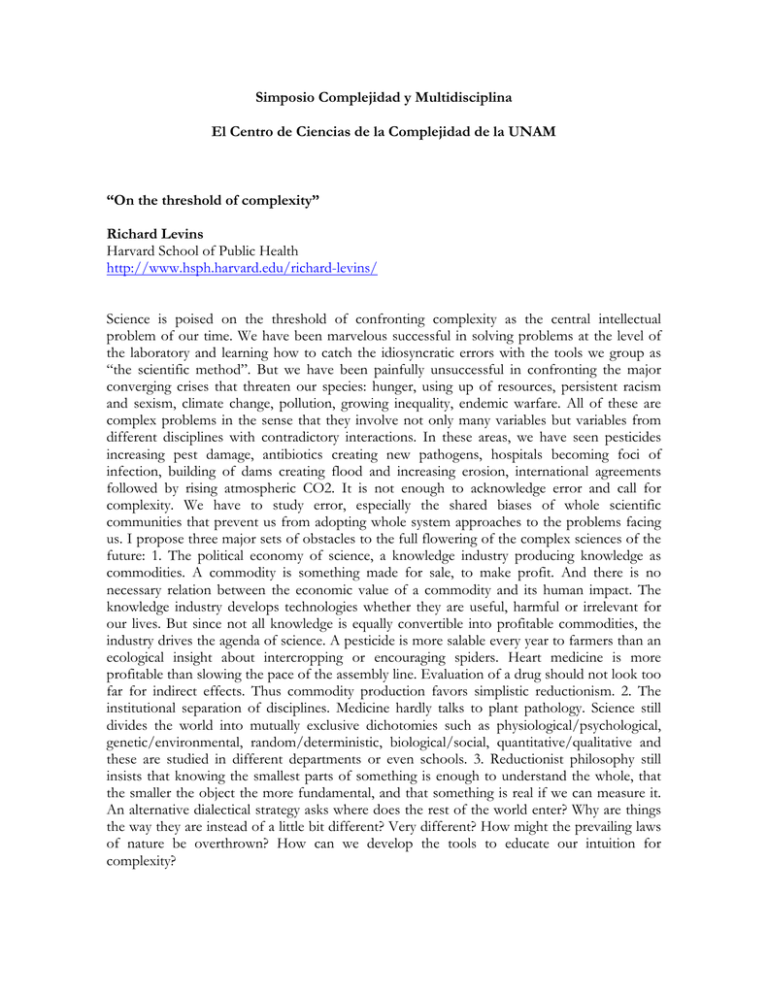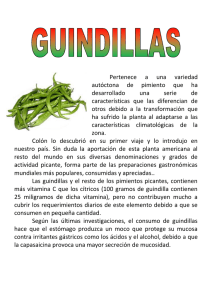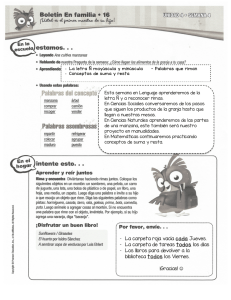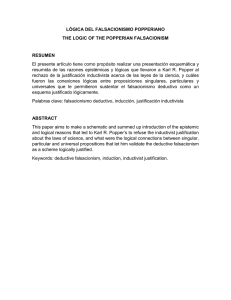On the threshold of complexity - Departamento de Ciencias de la
Anuncio

Simposio Complejidad y Multidisciplina El Centro de Ciencias de la Complejidad de la UNAM “On the threshold of complexity” Richard Levins Harvard School of Public Health http://www.hsph.harvard.edu/richard-levins/ Science is poised on the threshold of confronting complexity as the central intellectual problem of our time. We have been marvelous successful in solving problems at the level of the laboratory and learning how to catch the idiosyncratic errors with the tools we group as “the scientific method”. But we have been painfully unsuccessful in confronting the major converging crises that threaten our species: hunger, using up of resources, persistent racism and sexism, climate change, pollution, growing inequality, endemic warfare. All of these are complex problems in the sense that they involve not only many variables but variables from different disciplines with contradictory interactions. In these areas, we have seen pesticides increasing pest damage, antibiotics creating new pathogens, hospitals becoming foci of infection, building of dams creating flood and increasing erosion, international agreements followed by rising atmospheric CO2. It is not enough to acknowledge error and call for complexity. We have to study error, especially the shared biases of whole scientific communities that prevent us from adopting whole system approaches to the problems facing us. I propose three major sets of obstacles to the full flowering of the complex sciences of the future: 1. The political economy of science, a knowledge industry producing knowledge as commodities. A commodity is something made for sale, to make profit. And there is no necessary relation between the economic value of a commodity and its human impact. The knowledge industry develops technologies whether they are useful, harmful or irrelevant for our lives. But since not all knowledge is equally convertible into profitable commodities, the industry drives the agenda of science. A pesticide is more salable every year to farmers than an ecological insight about intercropping or encouraging spiders. Heart medicine is more profitable than slowing the pace of the assembly line. Evaluation of a drug should not look too far for indirect effects. Thus commodity production favors simplistic reductionism. 2. The institutional separation of disciplines. Medicine hardly talks to plant pathology. Science still divides the world into mutually exclusive dichotomies such as physiological/psychological, genetic/environmental, random/deterministic, biological/social, quantitative/qualitative and these are studied in different departments or even schools. 3. Reductionist philosophy still insists that knowing the smallest parts of something is enough to understand the whole, that the smaller the object the more fundamental, and that something is real if we can measure it. An alternative dialectical strategy asks where does the rest of the world enter? Why are things the way they are instead of a little bit different? Very different? How might the prevailing laws of nature be overthrown? How can we develop the tools to educate our intuition for complexity? “Enfermedades por degradación de los sistemas adaptativos complejos” Manuel Martínez Lavín Instituto Nacional de Cardiología Ignacio Chávez La medicina actual está basada en una ciencia lineal y reduccionista. Lineal porque busca una relación directa entre los síntomas (el efecto) y una lesión en alguna parte del cuerpo o al menos una alteración en los análisis de laboratorio (la causa). El conocimiento médico es tan vasto que hay sido artificialmente reducido a especialidades. Este tipo de medicina ha sido muy eficaz para explicar enfermedades lineales, sin embargo es incapaz de entender un grupo grande de padecimientos que provocan múltiples síntomas y que hemos denominado “enfermedades complejas”. Aproximadamente el 20% de todas las consultas médicas son debidas a estas enfermedades complejas incomprendidas y por ende maltratadas. Ejemplos; fibromialgia, síndrome de fatiga crónica y sus manifestaciones localizadas; síndrome témporo-maxilar, intestino irritado, cistitis no infecciosa y un largo etcétera. Estos padecimientos se traslapan entre ellos y están relacionados a estrés. Se pueden concebir como resultado de una respuesta maladaptativa al medio ambiente estresante. Nuestras investigaciones se han enfocado al estudio de la fibromialgia. Conceptos derivados de las ciencias de la complejidad tales como sistemas adaptativos complejos, fractales y holismo científico, ayudan a explicar estas enfermedades complejas. Nuestro principal sistema de regulación interna y de adaptación al medio ambiente – el sistema nervioso autónomo- es un sistema adaptativo complejo con finos circuitos realimentadores. Este sistema autónomo es también el componente principal de respuesta al estrés. Los órganos más importantes del cuerpo humano tienen estructura fractal. En situaciones normales, la variabilidad de la frecuencia cardiaca tiene organización fractal ya que las fluctuaciones son estadísticamente autosimilares en las diferentes escalas de tiempo. La fractalidad de los ritmos del corazón revela un sistema nervioso autónomo resiliente. Estudios recientes analizando la fractalidad de los ritmos de corazón proponen que las pacientes con fibromialgia tienen un sistema autónomo que ha perdido resiliencia y que tiene un comportamiento más rígido. Esta alteración ofrece una explicación coherente para los múltiples síntomas de la fibromialgia. En conclusión: Hay un grupo grande de padecimientos humanos no explicables mediante paradigmas lineales. Conceptos derivados de las ciencias de la complejidad proveen un marco teórico coherente para estos padecimientos. Tales enfermedades se pueden concebir como un intento fallido de nuestro principal sistema adaptativo complejo, para acomodarse a un medio ambiente hostil. El entendimiento de estos padecimientos demanda en acercamiento holístico basado en paradigmas complejos. “Cities as Complex Adaptive Systems” Luís M. A. Bettencourt Santa Fe Institute http://tuvalu.santafe.edu/~bettencourt @BettencourtLuis “Models of opinion formation in social networks” Rafael Ángel Barrio Instituto de Física, UNAM We shall present models of opinion formation in social networks based on the concept of coevolution, which implies the coupling of several dynamic changes in different time scales. This interplay of the dynamics causes the network to acquire a structure in which small communities tightly linked are weakly connected with others, as observed in real social networks. We shall exhibit mobile phone data to compare with our results. We extend the basic idea to include a dynamical change of the weights of the interactions based on the opinion divergence, and also to treat the general case in which the personal opinion of the agents in not publicly known, that is, there is room for information withholding, deception and lies. Our results show important features known in evolutive psychology. “Leadership and dominance in two different systems: flock of pigeons and pack of dogs” Máté Nagy Royal Society Newton Fellow Fulford JRF at Somerville College Department of Zoology, University of Oxford http://oxnav.zoo.ox.ac.uk/matenagy Hierarchical organisation is widespread in societies of humans and other animals. However, does the “alpha” individual necessarily have the most influence over group decisions? We measured social dominance and compared it to leadership within the same groups of animals during collective movement. To uncover general principles, we investigated two different systems: a flock of pigeons and a pack of dogs. The animals’ movement paths were recorded by high-resolution GPS loggers; for pigeons in flight and for dogs in a free running situation. Leader-follower events were detected by correlation-based method when one’s direction of motion was “copied” by another individual delayed in time. Collectively feeding pigeons were filmed and trajectories were extracted by autonomous computer-vision-based tracking. From the recorded paths the aggression-based social interactions (retreating, access to food) were automatically detected by novel quantitative analysis. The “automated methods” results were verified by a “pecking order” obtained from computer-aided manual identification of social interactions. In the case of dogs, data on dominance and behavioural variables were collected from questionnaires filled out by the owner and gained from ethological tests. For both pigeons and dogs, the dominance structures were compared with various physical parameters and with the same animals’ respective leadership roles during collective motion. For pigeons we found that birds’ ranks varied widely between the dominance and leadership contexts. The dogs' positions in the network correlated with the age, dominance rank order, trainability, controllability and aggression derived from personality questionnaires. This confirms that in societies with robust hierarchical dominance, alternative hierarchies may or may not exist during decision making. “Complexity, Computation, and Philosophy” Carlos Gershenson Instituto de Investigaciones en Matemáticas Aplicadas y en Sistemas, UNAM http://turing.iimas.unam.mx/~cgg/ @cgershen @cgg_mx The scientific study of complex systems has become possible because of computers. Our brains or previous tools cannot manipulate too many variables and interactions as computers can. Thus, computers have been similar to microscopes and telescopes, allowing us to explore complex phenomena. Historically, scientific advances have had implications in philosophy, since both are interested in understanding our world. The novel insights provided by complexity and computation require a philosophical reaction. In particular, I will argue that considering interactions (the essence of complex systems) as real as matter and energy implies the obsolescence of reductionism, materialism, predictability, Platonism, and nihilism. Alternatives for each of these will be suggested. Gershenson, C. (2013). The implications of interactions for science and philosophy. Foundations of Science, Early View. http://dx.doi.org/10.1007/s10699-012-9305-8 “Controlling the Behavior of Complex Networks” Adilson E. Motter Northwestern University, Evanston, USA http://dyn.phys.northwestern.edu Genetic diseases, ecosystem collapses, cascading failures, network synchronization, materials design. These are some of the many outstanding interdisciplinary problems that could benefit from a predictive modeling approach to control the perturbation response of complex networks. A fundamental property of networks is that perturbations to one node can affect other nodes, potentially causing the entire system to change behavior or fail. In this talk I will show that it is possible to exploit the same principle to control network behavior. The main obstacle to the development of such an approach has been that it is generally unclear how the large-scale collective behavior is affected by the local properties of the underlying interactions. I will discuss an approach recently developed in my research group, which is based on inverting this perspective and seeking instead the conditions that should be imposed on the local network structure and/or dynamics to generate a desired (natural or human-selected) global collective behavior. This approach accounts for the nonlinear dynamics inherent to real systems, and allows bringing the system to a desired state even when this state is not directly accessible due to constraints that limit the allowed interventions. I will discuss applications to processes as diverse as cascade control, network reprogramming, network rescue, and transient stability in genetic, ecological, mechanical, and power-grid networks. “Bioética y Complejidad” León Olivé Instituto de Investigaciones Filosóficas, UNAM Se hará una caracterización poco ortodoxa de la bioética como el análisis y crítica de las prácticas sociales humanas que tienen que ver con el fenómeno de la vida en el planeta. Esto abarca desde las prácticas biomédicas y en general las que están relacionadas con la salud, a las agrícolas y a las que afectan al medio ambiente. Enseguida se caracterizarán las prácticas sociales, haciendo énfasis en su estructura, incluyendo su estructura axiológica, y se subrayará que toda práctica social está inserta en un medio, al cual afecta y es afectada por ese medio. Entonces, la relación entre las prácticas y el medio, así como la forma en que se afectan entre sí, es compleja, como los son todas las prácticas y los medios en los cuales se desarrollan. Se concluirá con una breve discusión de algunas prácticas de salud, agrícolas, y de algunas que afectan al medio ambiente. “Integration of Economics and Transport Geography into the Network Science” Igor Lugo Centro Regional de Investigaciones Multidisciplinarias, UNAM https://sites.google.com/site/igorlugoolmos/ Network science is increasingly important to connect theories, models, and techniques among scientific perspectives. However, economics and transport geography have been developed in autonomous manner because of reductionism. The aim of this presentation is to show the integration of such perspectives into network theory, which is used as a main framework, connecting explicitly urban and transport studies. The result suggests a multidisciplinary approach to enhance our understanding of spatial phenomena. "Using Robots to Understand Complex Systems" Joshua C. Bongard Director of the Morphology, Evolution and Cognition Laboratory Vice-Chair of the Vermont Complex Systems Center Associate Professor in the Department of Computer Science University of Vermont http://www.cs.uvm.edu/~jbongard/ @DoctorJosh This talk will have three parts. In the first part of the talk I will discuss the history and current state of the University of Vermont's Complex Systems Center. In the second part of the talk I will discuss my own research program, in which we use robots to understand and build complex systems. In the third and final part of my talk I will describe my group's recent efforts to create an educational tool that allows people of all ages and from all countries to collectively perform their own robotics experiments. http://www.uvm.edu/~ludobots/ “De las redes genéticas a la formación de patrones en los seres vivos: patrones florales, células troncales y cáncer” Elena Álvarez-Buylla Instituto de Ecología, UNAM http://www.ecologia.unam.mx/ie/academicos/alvarez/alvarez_contacto.htm @eabuylla Se presentan modelos que permiten integrar gran cantidad de información genética y no genética subyacente a la diferenciación celular y formación de patrones en los sistemas vivos. Para analizar dinámicamente cómo la acción concertada de todos estos componentes interactuantes puede subyacer tras los patrones morfogenéticos normales y alterados hemos usado modelos de redes. Se explica cómo se construyen y validan experimentalmente estos modelos, y también cómo son útiles para plantear predicciones novedosas. Se ejemplifica este enfoque de biología de sistemas con ejemplos de desarrollo vegetal, y también del funcionamiento de los nichos de células troncales. Se discute finalmente cómo este tipo de modelos y enfoques pueden ayudar a entender la emergencia de crecimientos tumorales. “Evolutionary and Developmental Restrictions to Infinite Biological Complexity” Diego Rasskin-Gutman Theoretical Biology Research Group Institute Cavanilles for Biodiversity and Evolutionary Biology University of Valencia, Spain http://www.uv.es/biodiver/c/inve/grup_bio_teor.htm Biodiversity is the mark of our blue planet. Millions of different species co-exist on Earth while many more have gone extinct in the past three billion years. Comparing the beaks of birds, the petals of flowers, or the bodies of fishes makes us wonder if there are no limits to what nature can produce through evolution. Indeed, Darwin himself defined this wonder by ending The Origin of Species with one of the most elegant phrases in the history of scientific writing: "…from so simple a beginning endless forms most beautiful and most wonderful have been, and are being, evolved.“ Darwin expressed his sense of wonder by contrasting the word “simple” with the words “beautiful” and “wonderful,” implying that evolution had proceeded toward more complex forms. Ever since, authors have looked into the problem of evolutionary speciation encountering and creating fields of scientific inquiry to address questions still unsolved. What is biological complexity? Is there a complexity arrow in evolution? How complex is complexity? Can species evolve “endlessly” towards any kind of complexity? These questions help to put in perspective one of the most important issues in contemporary biology: What are the limits to biological evolution? "Unmasking the interaction between influenza and bacterial pneumonia" Pejman Rohani University of Michigan http://vserver1.cscs.lsa.umich.edu/~rohani/ The association between influenza infection and bacterial pneumonia has been mooted for more than two centuries. This has been proposed as a polymicrobial system, whereby transmission and pathogenicity of one pathogen (the bacterium) are affected by interactions with the other (the virus). However, studies focusing on different scales of resolution have painted an inconsistent picture: Individual-scale animal experiments have unequivocally demonstrated an association, whereas epidemiological support in human populations is, at best, inconclusive. We integrate weekly incidence reports and a mechanistic transmission model within a likelihood-based inference framework to characterize the nature, timing, and magnitude of this interaction. We find support for a strong but short-lived interaction, with influenza infection increasing susceptibility to pneumococcal pneumonia ~100-fold. We infer modest population-level impacts arising from strong processes at the level of an individual, thereby resolving the dichotomy in seemingly inconsistent observations across scales. An accurate characterization of the influenza-pneumococcal interaction can form a basis for more effective clinical care and public health measures for pneumococcal pneumonia. “Climate policy: Cooperation dynamics in an uncertain world” Francisco C. Santos* joint work with Jorge M. Pacheco and Vítor V. Vasconcelos * Instituto Superior Técnico, INESC-ID & ATP-group, Universidade de Lisboa, Portugal http://web.ist.utl.pt/franciscocsantos/ http://www.ciul.ul.pt/~ATP/ The welfare of our planet stands as a perfect example of what scientists commonly refer to as public goods — a global good from which everyone profits, whether or not they contribute to maintain it. Indeed, reducing the effects of global warming has been described as one of the greatest public goods problems (or “games”) we humans face, and the one we cannot afford to lose. Unfortunately, individuals, regions or nations may opt to be “free riders”, hoping to benefit from the efforts of others while choosing not to make any effort themselves. Cooperation problems faced by humans often share this setting, in which the immediate advantage of free riding drives the population into the “tragedy of the commons”, the ultimate limit of widespread defection. Moreover, nations and their leaders seek a collective goal that is shadowed by the uncertainty of its achievement. In this talk, I will discuss an evolutionary dynamics approach to a broad class of cooperation problems in which attempting to minimize future losses turns the risk of failure into a central issue in individual decisions. Our results suggest that global coordination for a common good should be attempted by segmenting tasks in many small to medium sized groups in which perception of risk is high and achievement of goals involves stringent requirements (whose meaning I will make precise). Moreover, whenever the perception of risk is low — as it is presently the case — we find that a polycentric approach involving multiple institutions is more effective than that associated with a single, global one, indicating that a bottom-up approach, setup at a local scale, provides a better ground on which to attempt a solution for such a complex and global dilemma. Finally, we show that, if one takes into consideration that individuals are interwoven in complex political networks, the chances for global coordination in an overall cooperating state are further enhanced “Diseño basado en sistemas complejos” Liliana B. Sosa Compeán. Universidad Autónoma de Nuevo León. El urbanismo, la arquitectura y el diseño industrial, tienen en común la actividad de diseñar en su quehacer. Diseñar es conjugar información de manera particular, conteniéndola en entidades, sistemas o conceptos de diversa índole, orientados hacia un fin. Esta disciplina se ha transformado a la par de los cambios en las dinámicas sociales y adelantos tecnológicos. En el contexto actual, surgen proyectos de diseño en donde se funden conocimientos de distintas disciplinas y toma auge la multifuncionalidad, autonomía, adaptabilidad y personalización de los objetos, edificios y espacios públicos. Para enfrentar los retos que esto implica, es indispensable identificar al objeto de diseño desde el enfoque de la complejidad para poder dar soluciones a problemas en contextos complejos y cambiantes. La naturaleza organizada en sistemas complejos adaptativos ha desarrollado diseños y estrategias de supervivencia increíblemente eficaces, por lo que un modelo de diseño basado en las dinámicas, patrones y procesos que estos sistemas comportan, nos puede dar las pautas para diseñar de una manera eficiente y efectiva los objetos que repliquen estas propiedades, tales como ciudades o matrices sociales; robots y sistemas inteligentes, hasta objetos de materiales vivos. “FUTURICT: Global computing for aour complex connected word” Anna Carbone Politecnico di Torino & Institute for Complex Systems of the National Research Concil, Università ‘La Sapienza di Roma’ & ETH Zurich http://www.polito.it/noiselab @AnnaFCarbone FuturICT (www.futurict.eu) is a visionary project that will deliver new science and technology to explore, understand and manage our connected world. This will inspire new information and communication technologies (ICT) that are socially adaptive and socially interactive, supporting collective awareness. Our increasingly dense interconnected world poses every day new challenges that need to be approached in several dimensions, at different temporal and spatial scales. In particular, given the scope and scale of the world's future Internet of everything, new technologies with the lowest energetic impact, unconventional computational schemes, novel phenomena and paradigm should be figure out for understanding and managing such increasing complexity Revealing the hidden laws and processes underlying our complex, global, socially interactive systems constitutes one of the most pressing scientific challenges of the 21st Century. Integrating complexity science with ICT and the social sciences, will allow us to design novel robust, trustworthy and adaptive technologies based on socially inspired paradigms. Data from a variety of sources will help us to develop models of techno-socioeconomic systems. In turn, insights from these models will inspire a new generation of socially adaptive, self-organised ICT systems. This will create a paradigm shift and facilitate a symbiotic co-evolution of ICT and society.







